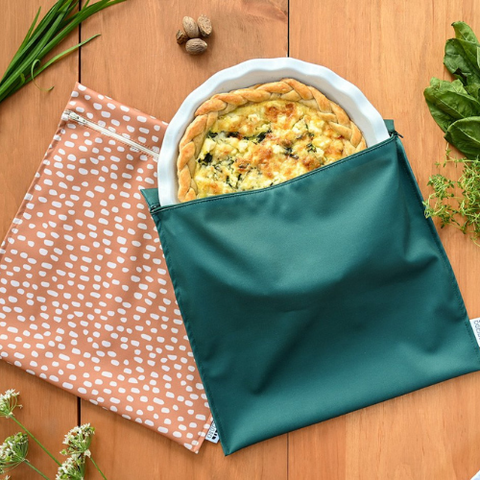According to the National Zero Waste Council, Canadian families waste an average of $1,300 on food annually. $1,300! It was after seeing this statistic that we came up with the idea of offering you some tips to develop your zero waste reflexes in the kitchen and save money at the same time.
Fridge and Freezer Management
The vast majority of food that is thrown away is because it was poorly stored or forgotten.
It is important to store food in the right place in the fridge and to use dishes or bags that are suitable for food. However, it is also important to know what is in our appliances! If space allows, dedicate a shelf to foods that need to be eaten or cooked as a priority: leftovers, foods that are approaching their expiration date, wilted vegetables or fruits, etc. Are you short on space? No problem, simply install an erasable board on the fridge door or use a piece of paper from the recycling bin to note down these foods to save from the compost. This tip also applies to the freezer, because sometimes food is lost because it has been burned by the freezer or because it tastes "freezer-like".
When preparing meals, look at your tablets or lists and challenge yourself to use one or more priority items. Also, establish a fridge-emptying day where each member of the family must be original by inventing a new recipe with leftovers. Also, you can build yourself a bible of all-purpose recipes for days lacking inspiration: fridge-emptying soup, meal-of-the-moment salad, leftover pasta, poke bowl, pizza, crumble, etc. Several recipe sites like Ricardo or Mordu offer inspiring recipes under the keywords all-purpose or fridge-emptying .
Sometimes, food cannot be cooked or eaten in time due to lack of time or because there is too much of it. In this case, develop the reflex to freeze it for future use and above all, do not forget to put it on your priority list! You can accumulate leftover vegetables together in a freezer bag for a future soup or leftover fruit for a crumble or smoothie. At home, we accumulate the unpopular bread crusts to create croutons or for a savory or sweet bread pudding.
Cook whole foods
Zero waste cooking also means learning to use as much of our food as possible. When you cook, take note of what you put in your compost. Afterwards, ask yourself if these “undesirable” or less noble parts could have been cooked in the original recipes or if they could be cooked differently.
Let's take two examples! The first is carrot peelings. If your original recipe was for soup, you might simply leave your carrots unpeeled. If necessary, the peelings can be stored in the freezer to add to a soup or to create a vegetable stock. You could also turn them into chips with other peelings.
The second example is herb stems. Since they are less tender than the leaves, you can turn them into pesto, savory herbs, or flavor an oil .
For ideas on other foods, the site I Love Fruits and Vegetables has a great section filled with anti-waste notebooks . Consult without moderation!

To plan
When planning your weekly menu, look at what you already have on hand to choose your first meals. If you need to buy new ingredients, make a note of which ones you won't cook from scratch.
Then choose recipes for these “leftover” ingredients to round out your menu. For example, if you know you’ll have some feta left over from your Greek salad recipe, you might plan to use it in stuffed vegetables or add it to a pasta salad.
Lacking inspiration? Les recettes d'ici have developed a tool to help us where you just have to enter the ingredient to use to get a list of recipes!
And you, what is your favorite tip or fridge-emptying recipe?
Ecologically yours,











0 comments